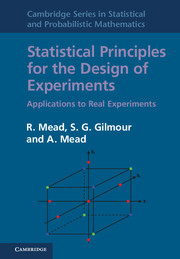Book contents
11 - Restricted randomisation
from Part II - First subject
Published online by Cambridge University Press: 05 November 2012
Summary
Preliminary example
An experiment to compare four varieties of tomato is to be run in a greenhouse at a horticultural research station. The greenhouse has 16 compartments in a 4 × 4 array. The initial proposal is to use a Latin square design, such as that shown in Figure 11.1(a), which is randomised, as in Chapter 8 by randomly permuting rows and columns, to give the square shown in Figure 11.1(b). On seeing the randomised design, the experimenter recalls that previous experiments in this greenhouse showed unusually high yields along the top-right to bottom-left diagonal and is concerned that this might bias the results in favour of variety D. She also notes that the situation is even worse in the unrandomised design.
One possible solution is to abandon the natural seeming 4 × 4 row-and-column structure and define blocks according to the distance from the top-right to bottom-left diagonal. However, this is not satisfactory either, since the experimenter has also previously observed row and column trends. Another possible solution is to restrict the randomisation more than usual to ensure that the design has all of the required properties.
Time-trend resistant run orders and designs
In industrial experiments, the experimental units are often sequential runs of the same process. The possibility of time trends needs to be allowed for, but resources are often too scarce to benefit from using very small blocks.
- Type
- Chapter
- Information
- Statistical Principles for the Design of ExperimentsApplications to Real Experiments, pp. 256 - 272Publisher: Cambridge University PressPrint publication year: 2012



